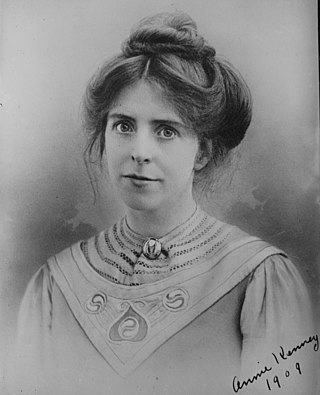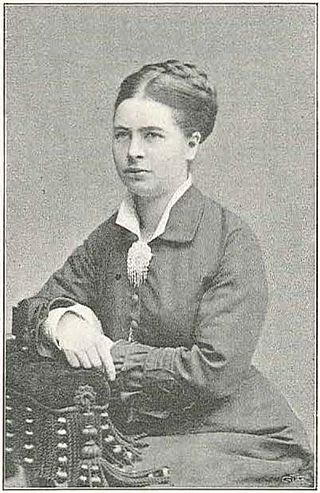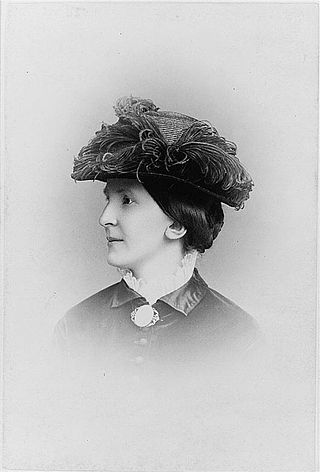
Kiruna is the northernmost city in Sweden, situated in the province of Lapland. It had 17,002 inhabitants in 2016 and is the seat of Kiruna Municipality in Norrbotten County. The city was originally built in the 1890s to serve the Kiruna Mine.

Piteå is a locality and the seat of Piteå Municipality in Norrbotten County, Sweden. Piteå is Sweden's 58th largest city, with a population of 23,326.

Anna Howard Shaw was a leader of the women's suffrage movement in the United States. She was also a physician and one of the first ordained female Methodist ministers in the United States.

Ann "Annie" Kenney was an English working-class suffragette and socialist feminist who became a leading figure in the Women's Social and Political Union. She co-founded its first branch in London with Minnie Baldock. Kenney attracted the attention of the press and public in 1905 when she and Christabel Pankhurst were imprisoned for several days for assault and obstruction related to the questioning of Sir Edward Grey at a Liberal rally in Manchester on the issue of votes for women. The incident is credited with inaugurating a new phase in the struggle for women's suffrage in the UK with the adoption of militant tactics. Annie had friendships with Emmeline Pethick-Lawrence, Baroness Pethick-Lawrence, Mary Blathwayt, Clara Codd, Adela Pankhurst, and Christabel Pankhurst.
Emma Maria Josefin Eliasson is a Swedish retired ice hockey player. Considered one of the greatest Swedish defenders to ever play the game and known for her offensive abilities and physical style of play, she averaged over a point per game in her 10-year SDHL career, playing in five SDHL championship finals, and made over 230 appearances for the Swedish national team, winning a silver medal at the 2006 Winter Olympics.

Charlotte Despard was an Anglo-Irish suffragist, socialist, pacifist, Sinn Féin activist, and novelist. She was a founding member of the Women's Freedom League, Women's Peace Crusade, and the Irish Women's Franchise League, and an activist in a wide range of political organizations over the course of her life, including among others the Women's Social and Political Union, Humanitarian League, Labour Party, Cumann na mBan, and the Communist Party of Great Britain.

Kurravaara is a village 12 km north of Kiruna in Kiruna Municipality, Norrbotten County, Sweden with 57 inhabitants in 2005.

Karolina Olivia Widerström, was a Swedish medical doctor and gynecologist. She was the first female physician with a university education in her country. She was also a feminist and a politician, and engaged in the questions of sexual education and female suffrage. She was chairwoman of the National Association for Women's Suffrage and a member of the Stockholm city council.

Anna Wilhelmina Hierta-Retzius, née Hierta, was a Swedish women's rights activist and philanthropist. She was the co-founder and secretary of the Married Woman's Property Rights Association (1873), founder and chairperson of the evening school Torsdagsskolan in 1864–1874, member of the board in the Bikupan association in 1870–1887, Vice Chairperson of the Married Woman's Property Rights Association in 1886–1893, member of the board of the Stiftelsen Lars Hiertas Minne in 1878-1911 and its Vice Chairperson in 1911–1924, co-worker in Aftonbladet in 1884–1887, founder of the Adolf Fredriks arbetsstuga för barn in 1887, Chairperson of the central committee of the Stockholm work houses in 1889–1909, chairperson of the Swedish National Council of Women (SKNF) in 1899–1911, Vice Chairperson of the International Council of Women (ICW) in 1904–1909.
The National Association for Women's Suffrage was a part of the general suffrage movement and the national society for women's suffrage in Sweden. It functioned as a parallel to the Sveriges allmänna rösträttsförbund which was active mainly in acquiring full suffrage for males. The LKPR was a part of the International Woman Suffrage Alliance. It was active locally from 1902 as the Föreningen för kvinnans politiska rösträtt, and nationwide as the Landsföreningen för kvinnans politiska rösträtt from 1903 until 1921.

The status and rights of Women in Sweden has changed several times throughout the history of Sweden. These changes have been affected by the culture, religion and laws of Sweden, as well as social discourses like the strong feminist movement.

Events from the year 1856 in Sweden
The Eighth Conference of the International Woman Suffrage Alliance occurred June 6–12, 1920, in Geneva, Switzerland.
Anna Maria Pettersson was a Swedish lawyer. She was the first woman in Sweden to set up a legal agency, run by a woman, which was aimed primarily at female clients. Pettersson was also active in the Swedish National Association for Women's Suffrage (FKPR).
Augusta Eleonora "Elin" Engström (1860–1956) was a Swedish politician and trade unionist. She belonged to the pioneers of the labour movement, the Social Democratic movement, as well as the trade unionism and women's rights movement within the Social Democratic labour movement in Sweden.

Elna (Ella) Billing née Wulff (1869–1921) was a Swedish women's rights activist and suffragist who initially contributed to the women's suffragist association (FKPR) in Kristianstad. She later travelled widely throughout Sweden, even to the far north, establishing suffrage associations. Billing wrote articles on suffrage for the association's journal Rösträtt för kvinnor. She proved to be a convincing speaker in the Stockholm branch of the National Association for Women's Suffrage.

Ebba Karolina Regina Hultqvist (1876–1955) was a Swedish teacher, suffragist and early female politician. From 1908, she served as a schoolteacher in Sölvesborg for over 30 years. Active in the suffrage movement, she headed the local women's association of the Liberal Party and was the first woman to be elected to the Sölvesborg Town Council. Hultqvist donated money to support music, education and childcare in the town.

Karolina Kristina Själander (1841–1925) was a Swedish headmistress, women's rights activist, suffragist and politician. A strong supporter of school education for girls, she was headmistress of the Elsa Borg Girls' School in Gävle from 1870 to 1915. As a result of its increasing popularity, in 1878 she funded the construction of a larger building for the school, later known as the Själander School. In 1903, she founded and chaired the Gävle branch of the National Association for Women's Suffrage (LKPR) and in 1910 was elected to the Gävle City Council.

Emma Josefina Isakson (1880–1952) was a Swedish newspaper publisher and suffragist who is remembered for her activity in Luleå at a time when few women gained positions of influence. From the age of 17, she worked for the daily newspaper Norbottens-Kuriren which she headed from 1945. She was also active in women's rights, acting as treasurer for the Luleå branch of the National Association for Women's Suffrage (LKPR) from its inception at the turn of the century.

Märta Kristina Boman née Lindau (1902–1986) was a Swedish politician who was the first woman to represent the Right Party (Högerpartiet) in the Norrbotten County constituency. She was elected as a member of the lower house of the Riksdag from 1945 to 1964. Representing a constituency in the far north of Sweden, she took an interest in the local Sámi peoples. Boman was also deputy chair of the Right Party's women's association Högerns kvinnoförbund and served on the party's executive committee.















